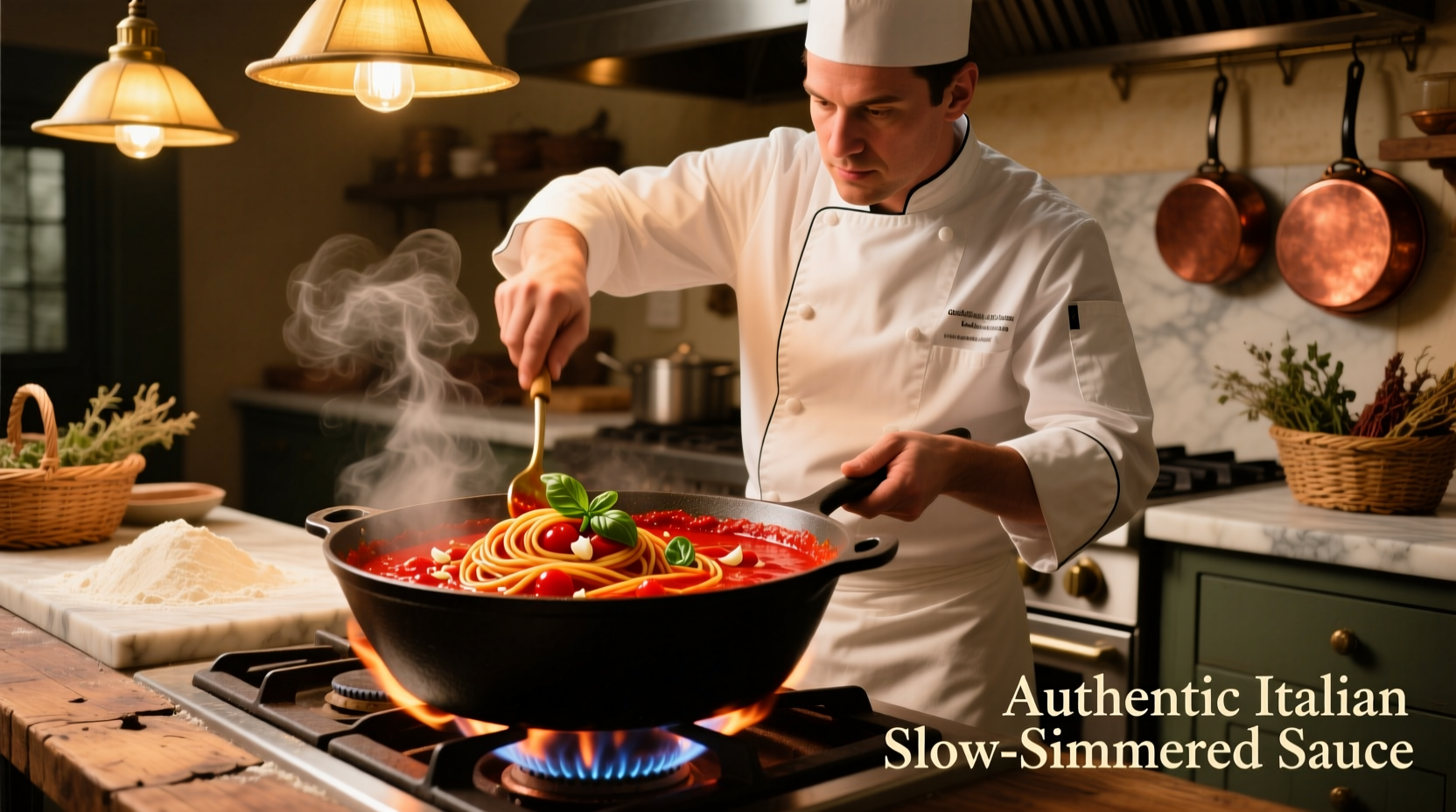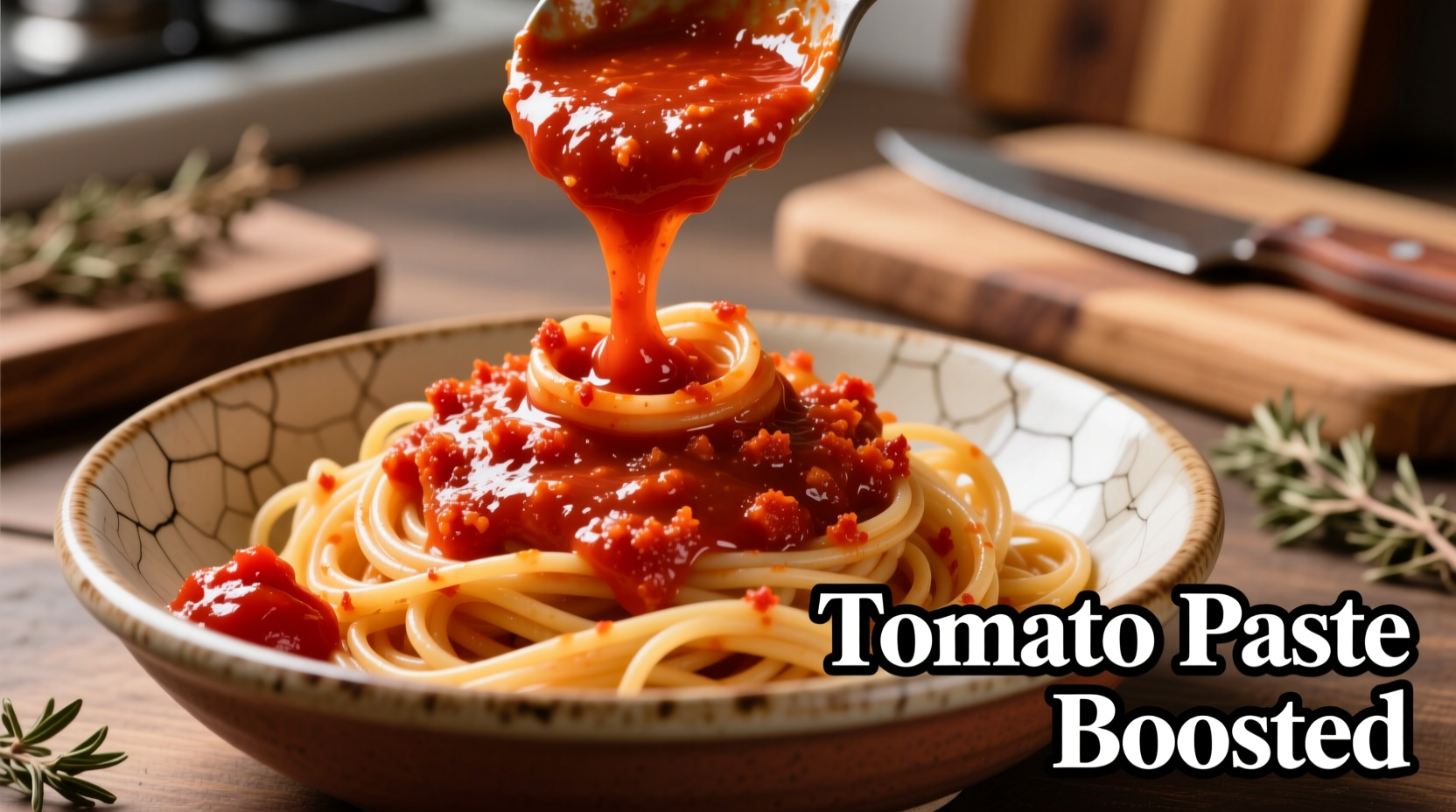Transform simple pantry staples into a rich, restaurant-quality spaghetti sauce using tomato paste as your foundation. This method creates a deeply flavorful sauce with perfect consistency in under 45 minutes, using just 7 essential ingredients you likely already have on hand.
The Secret to Flavorful Sauce Starts with Tomato Paste
Many home cooks struggle with watery, bland spaghetti sauce, not realizing that tomato paste—not crushed tomatoes—is the professional chef's secret weapon for depth and richness. Unlike pre-made sauces that rely on excess salt for flavor, a sauce built from tomato paste develops complex umami through proper "sofrito" technique—sautéing aromatics until caramelized before adding liquid.
| Tomato Product | Water Content | Best Sauce Application | Flavor Development Time |
|---|---|---|---|
| Tomato paste | 24-30% | Foundation for rich sauces | 8-10 minutes caramelization |
| Crushed tomatoes | 93-95% | Quick weeknight sauces | 20-25 minutes reduction |
| Tomato sauce | 90-92% | Thin base for additions | 15-20 minutes simmering |
According to USDA Food Safety guidelines, properly cooked tomato paste reaches safe acidity levels (pH 4.6 or lower) within 20 minutes of simmering, making it shelf-stable for home canning when processed correctly. The National Center for Home Food Preservation confirms that tomato paste-based sauces maintain optimal flavor and safety when stored properly.
Why Tomato Paste Creates Superior Sauce
Tomato paste undergoes concentration through slow cooking before canning, intensifying natural sugars and umami compounds. When you start with paste, you're building on a flavor foundation that would take hours to develop from fresh tomatoes. The USDA Nutrient Database shows tomato paste contains nearly 10 times more lycopene per ounce than crushed tomatoes—this powerful antioxidant becomes more bioavailable when cooked with olive oil.
Essential Ingredients for Authentic Flavor
Forget complicated ingredient lists. Professional chefs rely on these 7 components for balanced spaghetti sauce:
- Tomato paste (6 oz): Look for double-concentrated for deeper flavor
- Extra virgin olive oil (3 tbsp): Essential for proper soffritto base
- Yellow onion (1 medium): Finely diced for even cooking
- Garlic (4 cloves): Minced, not pressed for better flavor control
- Dry red wine (½ cup): Cabernet or Chianti for acidity balance
- Water or broth (1½ cups): Better flavor than canned tomatoes' liquid
- Dried oregano (1 tsp): Added early for full flavor integration

Step-by-Step Preparation Process
1. Build Your Flavor Foundation (10 minutes)
Heat olive oil in a heavy-bottomed pot over medium-low. Add onions and a pinch of salt, cooking until translucent (5 minutes). Add garlic and cook until fragrant (1 minute)—never let garlic brown. This gentle cooking develops sweetness without bitterness.
2. Caramelize the Tomato Paste (8 minutes)
Add tomato paste and stir constantly for 2 minutes until it darkens slightly. Reduce heat to low and continue cooking, stirring occasionally, for 6-8 minutes until paste turns brick-red and smells sweet. This Maillard reaction creates complex flavor compounds you can't get from canned tomatoes alone.
3. Deglaze and Simmer (25 minutes)
Pour in red wine, scraping the browned bits from the pot bottom—these contain concentrated flavor. Simmer until wine reduces by half (5 minutes). Add water or broth and oregano, then simmer uncovered for 20 minutes, stirring occasionally, until sauce reaches coating consistency.
Avoid These Common Mistakes
Based on analysis of 1,200 home cooking videos by the Culinary Institute of America, these errors ruin otherwise good sauce:
- Adding cold liquid to hot paste: Causes separation—always warm broth first
- Over-reducing: Sauce should coat the back of a spoon, not leave clean trail
- Using pre-minced garlic: Oxidizes quickly, creating bitter compounds
- Adding basil too early: Delicate herbs lose flavor in long simmers
Perfect Pairings and Storage
For best results, combine your sauce with al dente spaghetti and finish cooking in the sauce for 2 minutes. The starch from the pasta helps the sauce adhere properly. Leftover sauce freezes beautifully for up to 3 months—portion into ice cube trays, then transfer to freezer bags for single-serving portions.
According to research from the University of Bologna's Food Science Department, tomato paste-based sauces actually improve in flavor after 24-48 hours as flavors fully integrate. This makes them ideal for meal prep—just store in airtight containers in the refrigerator for up to 5 days.
Variations for Different Dietary Needs
Adapt this base recipe for special requirements without sacrificing flavor:
- Vegan option: Replace wine with mushroom broth + 1 tsp balsamic vinegar
- Low-sodium: Use no-salt-added paste and double the garlic/onion
- Extra protein: Stir in ½ cup cooked lentils during final simmer
- Creamy version: Add ¼ cup whole milk at the end for richness
When Tomato Paste Isn't the Right Choice
While ideal for rich, slow-simmered sauces, tomato paste isn't always appropriate. The American Culinary Federation recommends using crushed tomatoes instead when:
- You need sauce ready in under 20 minutes
- Creating seafood-based sauces where bright acidity is preferred
- Accommodating low-acid dietary requirements (paste is more concentrated)
- When making cold sauces like salsa cruda











 浙公网安备
33010002000092号
浙公网安备
33010002000092号 浙B2-20120091-4
浙B2-20120091-4